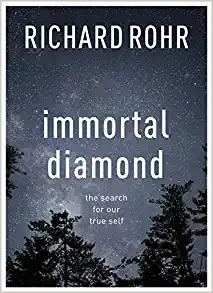We are not gathering for our discussion tonight. Next Tuesday, April 23, we will begin our study of Richard Rohr’s book: Immortal Diamond: The Search for Our True Self. This will be our fifth year in engaging with the Christian contemplative tradition during Eastertide.
Fr. Rohr (b.1943) is a Franciscan (Roman Catholic) priest and the founder of the Center for Action and Contemplation in Albuquerque, New Mexico. His book is about transformation and how the Resurrection of Jesus Christ is not simply a historical event, but, more importantly, is a present reality in which we can participate. As Paul writes, we are crucified with Christ and Christ was raised from the dead so that we too might walk in a new and transformed life. Rom 6:4-11. For if anyone is in Christ, he is a new creation, and the old has passed away. 2 Cor. 5:17. Particularly during the Easter season we are called to die to our old ego-centric self, and be resurrected and transformed into a new Christ-centric self. It is this Christ-centric self that is Rohr’s Immortal Diamond.
Rohr’s teachings, both in the book and otherwise, are based upon what he calls the Perennial Tradition. This Tradition consists of three pillars. First, there is a Divine Reality underneath and inherent in all things. See, Col. 1:15-20, 27, Acts 17:28. God does not exist somewhere out there, rather the divine essence pervades all of creation. As Jesus says, the “Kingdom of God is within you.” Luke 20:21.
The second pillar is a recognition that there is a longing in every human soul for this Divine Reality. See, Rom. 8:22, Acts 17:27. All cultures have religions and rites and philosophies that attempt to connect with this Reality. This longing is seen from the most basic animistic religions to the philosophies of Plato or the Tao. In the Scriptures, we see this most clearly in Luke’s description of Mars Hill in Athens. Acts 17:16-34.
The third pillar of the Perennial Tradition is that the final goal of existence is union with the Divine Reality. See, 2 Peter 1:4, John 1:12, Gal. 4:6. This goal is called Divinization in the Western Church and Theosis in Eastern Christianity. It is the ancient Christian teaching that the Word of God “assumed our humanity, that that we might become as God.” On the Incarnation, s.54. In Rohr’s book, finding the true self is finding that Divine Reality within us to that we may become participants in that Divine Reality.
Overall, the importance of the Perennial Tradition to Rohr is that it does not tell us how to get somewhere as if God resides in a spatially geographic place. Rather, this mystical and contemplative Tradition tells us simply how to be still and come to know God. Ps. 46:10. Our ultimate calling is not to do great things or believe certain propositions, but to awaken to the reality that is within us, so that we may have eyes that see (Isa. 6:10) the light that is Christ (John 8:12).
If you know of anyone that is “spiritual but not religious,” this is a wonderful introduction to Christian spirituality. Rohr draws on a very broad spiritual tradition and (unlike me) he generally avoids head-knowledge discussions but focuses on heart-knowledge matters. This makes the book very approachable, particularly for people without a strong religious background.
Syllabus:
April 23 – Invitation and Chapter 1 “What is the ‘True Self’”
April 30 – Chapter 2 “What is the ‘False Self’”
May 7 – Chapter 3 “What Dies and Who Lives” and Chapter 4 “The Knife Edge of Experience”
May 14 – Chapter 5 “Thou Art Thou” and Chapter 6 “If It Is True, It Is True Everywhere”
May 21 – Chapter 7 “Enlightenment at Gunpoint”
May 28 – Chapter 8 “Intimate with Everything” and Chapter 9 “Love Is Stronger Than Death”
By God’s power, presence, and essence, God is the One whose center is everywhere and whose circumference is nowhere. God exists uncircumscribed in everything. . . . God is, therefore, all inclusive. God is the essence of everything. God is most perfect and immense: within all things, but not enclosed; outside all things, but not excluded; above all things, but not aloof; below all things, but not debased. Finally, therefore, this God is all in all (1 Cor. 15:28). . . . Consequently, from him, through him and in him, all things exist.
St. Bonaventure, The Soul’s Journey to God,

